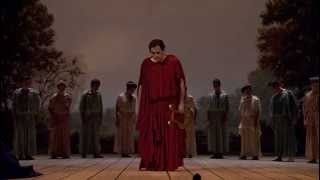Each Orfeo seemed to follow the same vocal score. Likewise, each production seems to have a similar Baroque ensemble size supporting him. Nigl was distinctive, however, in his enunciation of "Tu se' morta," with more trill on the "r" and an audible breath at the end. Sells was decidedly more reserved, though I suspect the resonance of his voice was affected by what appeared to be a more intimate venue than the other two productions. He does, however, put a melismatic twist on "le stelle" (1:37) that is not performed by the other Orfeos. In their farewells, Zanasi and Sells roll their voices forward with fullness, while Nigl, in stark contrast, says his with clarity, but resignation. I enjoy the way all three of them add mid-lyric accents to the first syllable of the the last "addio."
The visual presentations of each, as paired with the arioso, were quite different and each offered a unique experience. Zanasi begins with his head hung, shoulders slack, clearly in mourning, as is the darkened chorus behind him. They wear loose robes that earlier moved with an airy joy, but now hang like the torn emotions that weigh them down. Nigl's composure is much more tense, as if repressing anger. The costuming, makeup, and lighting of Orfeo and the chorus are similarly on edge, with lips and eyes marked to draw attention to every movement, and sickly blue light that doesn't allow the observer to find comfort. Sells is quite different from either the Zanasi or Nigl productions. Sells shows no bodily expression from within his modest costuming and one is left to ascertain the mood from his voice, the small orchestra that supports him, and the actors behind him. The actors, reflecting all light in their white, non-descript uniforms, are more distraction than chorus, as they move awkwardly through choreography that someone might describe as representative of the emotions Sells is attempting to express.
These productions are each unique artistic variations on this clip of Monteverdi's "Tu se' morta" from Orfeo. I would recommend the Zanasi version to someone interested in experiencing what I believe is the classical Greek representation of the opera, and the Nigl version for a person who seeks emotional surprise in their concert experiences. I would recommend the Sells version only to someone who is a declared Monteverdi enthusiast who desires to see how one can stretch the imagination of opera production.









